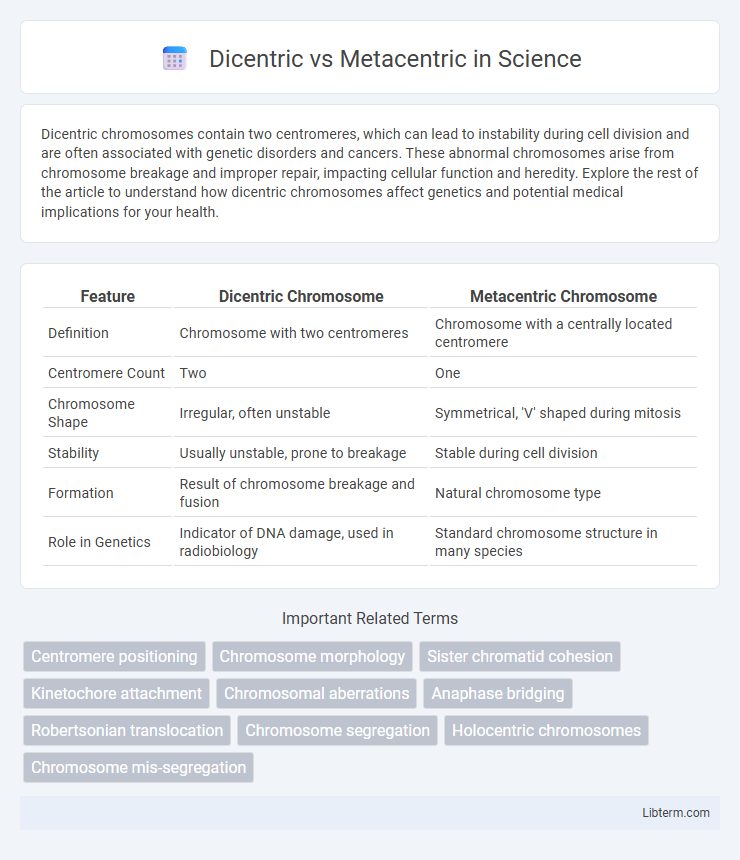Dicentric chromosomes contain two centromeres, which can lead to instability during cell division and are often associated with genetic disorders and cancers. These abnormal chromosomes arise from chromosome breakage and improper repair, impacting cellular function and heredity. Explore the rest of the article to understand how dicentric chromosomes affect genetics and potential medical implications for your health.
Table of Comparison
| Feature | Dicentric Chromosome | Metacentric Chromosome |
|---|---|---|
| Definition | Chromosome with two centromeres | Chromosome with a centrally located centromere |
| Centromere Count | Two | One |
| Chromosome Shape | Irregular, often unstable | Symmetrical, 'V' shaped during mitosis |
| Stability | Usually unstable, prone to breakage | Stable during cell division |
| Formation | Result of chromosome breakage and fusion | Natural chromosome type |
| Role in Genetics | Indicator of DNA damage, used in radiobiology | Standard chromosome structure in many species |
Introduction to Chromosome Structures
Dicentric chromosomes contain two centromeres, often leading to instability during cell division, whereas metacentric chromosomes have a single, centrally located centromere that ensures balanced chromosomal segregation. The centromere's position determines chromosome classification and influences gene expression and chromosomal behavior in mitosis and meiosis. Chromosome structure variations, such as metacentric and dicentric forms, play crucial roles in genetic stability and evolutionary processes.
Definition of Dicentric Chromosomes
Dicentric chromosomes are abnormal chromosomes characterized by the presence of two centromeres, resulting from chromosomal rearrangements such as translocations or fusions. Unlike metacentric chromosomes, which have a single centrally located centromere ensuring proper segregation during cell division, dicentric chromosomes often lead to genomic instability and can cause anaphase bridges or chromosome breakage. These structural abnormalities are significant in cancer genetics and chromosomal disorders, highlighting their impact on cell viability and genetic integrity.
Definition of Metacentric Chromosomes
Metacentric chromosomes have a centrally located centromere, resulting in two arms of equal length that create a V-shaped structure during cell division. This balanced arm length distinguishes metacentric chromosomes from dicentric chromosomes, which contain two centromeres and often lead to chromosomal instability. Metacentric chromosomes are common in human karyotypes and play a critical role in maintaining genetic stability.
Structural Differences: Dicentric vs Metacentric
Dicentric chromosomes contain two centromeres, leading to potential instability during cell division due to the formation of an anaphase bridge. Metacentric chromosomes have a single centromere centrally located, resulting in arms of roughly equal length that facilitate balanced segregation. The structural difference impacts genetic stability and chromosome behavior during mitosis and meiosis.
Formation Mechanisms of Dicentric Chromosomes
Dicentric chromosomes form primarily through abnormal chromosomal breakage and fusion events during DNA repair processes, such as non-homologous end joining (NHEJ), where two chromosome fragments with centromeres are incorrectly joined. In contrast, metacentric chromosomes arise through balanced Robertsonian translocations involving centromere repositioning without creating two active centromeres. The presence of two functional centromeres in dicentric chromosomes leads to genomic instability during cell division, distinguishing their formation mechanism from the structurally stable metacentric chromosomes.
Biological Role of Metacentric Chromosomes
Metacentric chromosomes, characterized by a centrally positioned centromere, play a crucial role in ensuring equal segregation of genetic material during cell division, which is essential for maintaining genomic stability. Their balanced arms facilitate proper attachment to spindle fibers, reducing the risk of chromosomal abnormalities and aneuploidy. Compared to dicentric chromosomes, which contain two centromeres and often lead to chromosomal breakage or missegregation, metacentric chromosomes contribute significantly to accurate chromosomal inheritance and cellular function.
Genetic Implications and Stability
Dicentric chromosomes contain two centromeres, leading to instability during cell division due to the potential for chromosome breakage or missegregation, which can cause genetic disorders or cell death. Metacentric chromosomes have a single, centrally located centromere, providing structural stability and balanced genetic segregation during mitosis and meiosis. The presence of dicentric chromosomes often results in genetic instability, increasing the risk of chromosomal abnormalities and diseases such as cancer, whereas metacentric chromosomes contribute to genomic integrity.
Detection and Identification Methods
Dicentric and metacentric chromosomes are primarily detected and identified using cytogenetic techniques such as G-banding and fluorescence in situ hybridization (FISH), which enable visualization of chromosomal structures and centromere positions. Dicentric chromosomes display two centromeres clearly distinguishable by centromeric-specific probes in FISH, while metacentric chromosomes exhibit a single centromere centrally located, confirmed through precise karyotyping and centromere enumeration probes. Advanced imaging software combined with automated chromosome analysis enhances the accuracy and efficiency of identifying these chromosomal abnormalities in clinical and research settings.
Clinical Significance and Disorders
Dicentric chromosomes, containing two centromeres, often result in genomic instability leading to disorders such as cancer and congenital malformations due to breakage during cell division. Metacentric chromosomes, with centrally located centromeres, are typically stable, but structural abnormalities like Robertsonian translocations can cause conditions such as Down syndrome and infertility. Understanding the differences in centromere positions aids in diagnosing chromosomal disorders and guiding genetic counseling.
Summary: Key Differences and Importance
Dicentric chromosomes contain two centromeres, leading to instability during cell division and potential chromosomal breakage, whereas metacentric chromosomes have a single, centrally located centromere ensuring proper segregation. The stability of metacentric chromosomes is crucial for maintaining genomic integrity, while dicentric chromosomes often result from chromosomal rearrangements associated with genetic disorders and cancer. Understanding these differences is vital for cytogenetic analysis, diagnostic applications, and studying chromosome behavior in genetics and cell biology.
Dicentric Infographic

 libterm.com
libterm.com